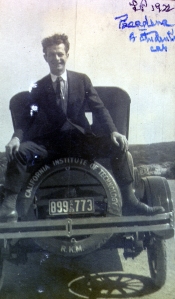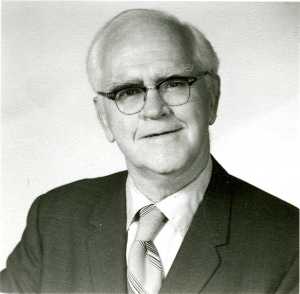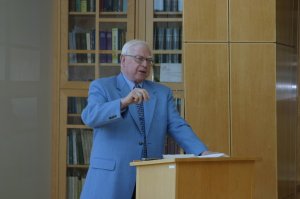
[The third and final installment of our look at Linus Pauling’s experience of the 1919-1920 academic year at Oregon Agricultural College.]
Campus life during the 1919-1920 school year was generally more lighthearted than had been the case during the previous few years; a time period defined largely by the horrors of World War I. War-time bans on major social gathering were lifted, making way for near weekly dances and school-sanctioned social events for all students to attend.
A major point of emphasis to kick off the school year was Homecoming Weekend. Beginning with a parade and rally held on the night of Friday, October 24th, and continuing through a home football game versus Stanford on Saturday (a 14-6 loss for the Aggies) and a campus church service on Sunday, Homecoming was a festive occasion meant to built bridges between students, faculty, and alumni. Unfortunately for Linus Pauling, his obligations to the state highway department resulted in his arriving on campus two weeks after the celebrations were over.
While not a student during the 1919-1920 academic year, Pauling still lived at the Gamma Tau Beta house as a faculty member. This was a regular practice at the time, especially for those who were unmarried. Professors whose names now adorn buildings at Oregon State University – individuals including Ava Milam, Grant Covell, Richard Dearborn, and Samuel Graf – were all members of various Greek organizations on campus.
A major highlight of the school year for the Gamma Tau Beta fraternity was their annual house dance, held on February 3rd, 1920. The house hired the Duke Vaughn Jazz Band to provide the entertainment and hosted a variety of faculty, alumni and out-of-town guests in addition to current Aggies.

“Here’s to men we know and love, / Beavers tried and true; / Here’s to the men of the orange line / Wiping the ground with you; / Up with the glass and pledge them, lads, / Flashing its amber gleam, / While deep in our hearts the toast shall be: / Here’s to the Old O.A.C.”
-“Toast to the Team”
Sports played an outsized role in campus social life, and for those who didn’t compete on OAC’s varsity teams there were many opportunities to participate in intramural activities. Recognized today as the third oldest program in the country, intramural sports at OAC operated under the motto of “Everybody in Sports” and worked throughout the year to include the participation of as many male students as possible. Pauling’s fraternity, Gamma Tau Beta, was very successful athletically, winning the college’s baseball divisions in both fall and spring, and placing second in cross country.
Women’s intramurals were not as well developed at OAC, but the college did offer opportunities for female students to compete in basketball, field hockey, swimming, and tennis. Through the Women’s Athletic Association, women at OAC also had the chance to practice baseball, volleyball, archery, fencing, soccer, and hiking. Relatively few actual games were scheduled during the school year due to a lack of teams and fears related to the influenza outbreak.
Beyond sports, OAC’s students took advantage of access to a number of different recreational pastimes including The Mask and Dagger Dramatic Club, and the Glee and Madrigal Clubs. In the winter, Mask and Dagger joined forces with the Glee Club to produce the school play, “The Importance of Being Earnest.” Student publications were another way to get involved on campus, be it through The Barometer newspaper, The Beaver yearbook or school-aligned quarterlies like The Student Engineer and The Oregon Countryman.

The recreational group with which Pauling was most closely associated was the Triangular Debate team, which offered the school’s best speakers the chance to compete intercollegiately. While Pauling was not eligible to participate during the year, his close friend Paul Emmett did compete in two separate debates, while also serving as the Forensics Manager for the sophomore class, one year beneath him in standing.
Emmett’s first competition was against the University of Oregon, during which he represented the negative argument to “Resolved, that the principles of the Chinese Exclusion Act should be applied to all immigration to this country for a period of not less than five years.” Later in the year, Emmett competed against the University of Washington, once again representing the negative positing on “Resolved, that the peace conference should have awarded the province of Shantung to China.” After graduating from OAC, Emmett earned a Ph.D. from Caltech and went on to become one of the foremost catalysis chemists of the twentieth century.
Traditions, even in the relatively early years of OAC’s history, were extremely important. Freshmen – more commonly known as “rooks” – were required to don green caps (for boys) or green ribbons (for girls) when on campus. To enforce these and other rules, the sophomore class was charged with forming a Vigilance Committee, which could mete out demerits and other punishments – including paddlings – for violations that they observed.
Important traditions for the junior class, to which Pauling would have belonged had he been able to return as a student, included Junior Prom, Beaver Annual, and Junior Flunk Day. Junior Prom was held in the Men’s Gymnasium (present-day Langton Hall), which was decorated with orange and black crepe paper, and attended by many school faculty. Junior Flunk Day was devoted to games contested between and within classes, as well as pranks pulled by juniors on the unassuming.

Students at OAC weren’t just busy playing intramural sports and attending school dances, many also maintained a keen interest in state politics. One continuing point of conversation was the fact that, in 1920, the U.S. dollar was worth approximately half as much as had been the case in 1913, yet all other university expenses had gone up. (Incomes had also risen a mere 4%.) During that same period of time, enrollment at Oregon’s primary institutions of higher learning – including the University of Oregon, Oregon Agricultural College, and Oregon State Normal School – had grown by 150% though classrooms had only barely increased in size.
As a potential corrective, students writing in The Barometer and elsewhere encouraged the citizenry to vote yes on the Higher Educational Tax Act, which would provide a boost in funding for the state’s colleges by increasing personal income taxes throughout Oregon. The measure passed in 1920, but was not enacted until the beginning of 1921.
In addition to stressing students’ budgets, funding woes for higher education in Oregon also hamstrung OAC’s ability to retain some of the temporary faculty that it had hired during the 1919-1920 school year, Linus Pauling among them. Fortunately, Pauling had built his savings up enough over the course of the year to re-enroll as a student for the fall 1920 quarter.
Retaining faculty was likewise encumbered at OAC by sub-standard facilities. The college was in especially dire need of a new auditorium as well as new Commerce, Home Economics, Pharmacy, and Engineering buildings. While a new engineering laboratory – present-day Graf Hall – began construction in November 1919 just off of Monroe Street, the other much needed buildings had to wait for several more years.
Filed under: Pauling and Oregon | Tagged: Linus Pauling, oratory, Oregon Agricultural College, Paul Emmett | Leave a comment »






![1902i.002-[36]-300dpi-900w](https://paulingblog.files.wordpress.com/2017/07/1902i-002-36-300dpi-900w.jpg)
![1906i.002-[16]-300dpi-900w](https://paulingblog.files.wordpress.com/2017/07/1906i-002-16-300dpi-900w.jpg)
![1908i.1-[33]-300dpi-900w](https://paulingblog.files.wordpress.com/2017/07/1908i-1-33-300dpi-900w.jpg)

![1917i.003-[123]-300dpi-900w](https://paulingblog.files.wordpress.com/2017/07/1917i-003-123-300dpi-900w.jpg)
![1918i.029-[21]-300dpi-900w](https://paulingblog.files.wordpress.com/2017/07/1918i-029-21-300dpi-900w.jpg)
![1918i.033-[3694]-300dpi-900w](https://paulingblog.files.wordpress.com/2017/07/1918i-033-3694-300dpi-900w.jpg)
![1920i.027-[62]-300dpi](https://paulingblog.files.wordpress.com/2017/07/1920i-027-62-300dpi.jpg)
![1920i.052-[27]-300dpi-900w](https://paulingblog.files.wordpress.com/2017/07/1920i-052-27-300dpi-900w.jpg)

![1922i.014-[1002]-300dpi-900w](https://paulingblog.files.wordpress.com/2017/07/1922i-014-1002-300dpi-900w.jpg)
![1924i.027-[330]-300dpi-900w](https://paulingblog.files.wordpress.com/2017/07/1924i-027-330-300dpi-900w.jpg)
![1925i.002-[421]-300dpi-900w](https://paulingblog.files.wordpress.com/2017/07/1925i-002-421-300dpi-900w.jpg)
![1925i.013-[823]-300dpi-900w](https://paulingblog.files.wordpress.com/2017/07/1925i-013-823-300dpi-900w.jpg)
![1926i.062-[3568]-300dpi-900w](https://paulingblog.files.wordpress.com/2017/07/1926i-062-3568-300dpi-900w.jpg)







































